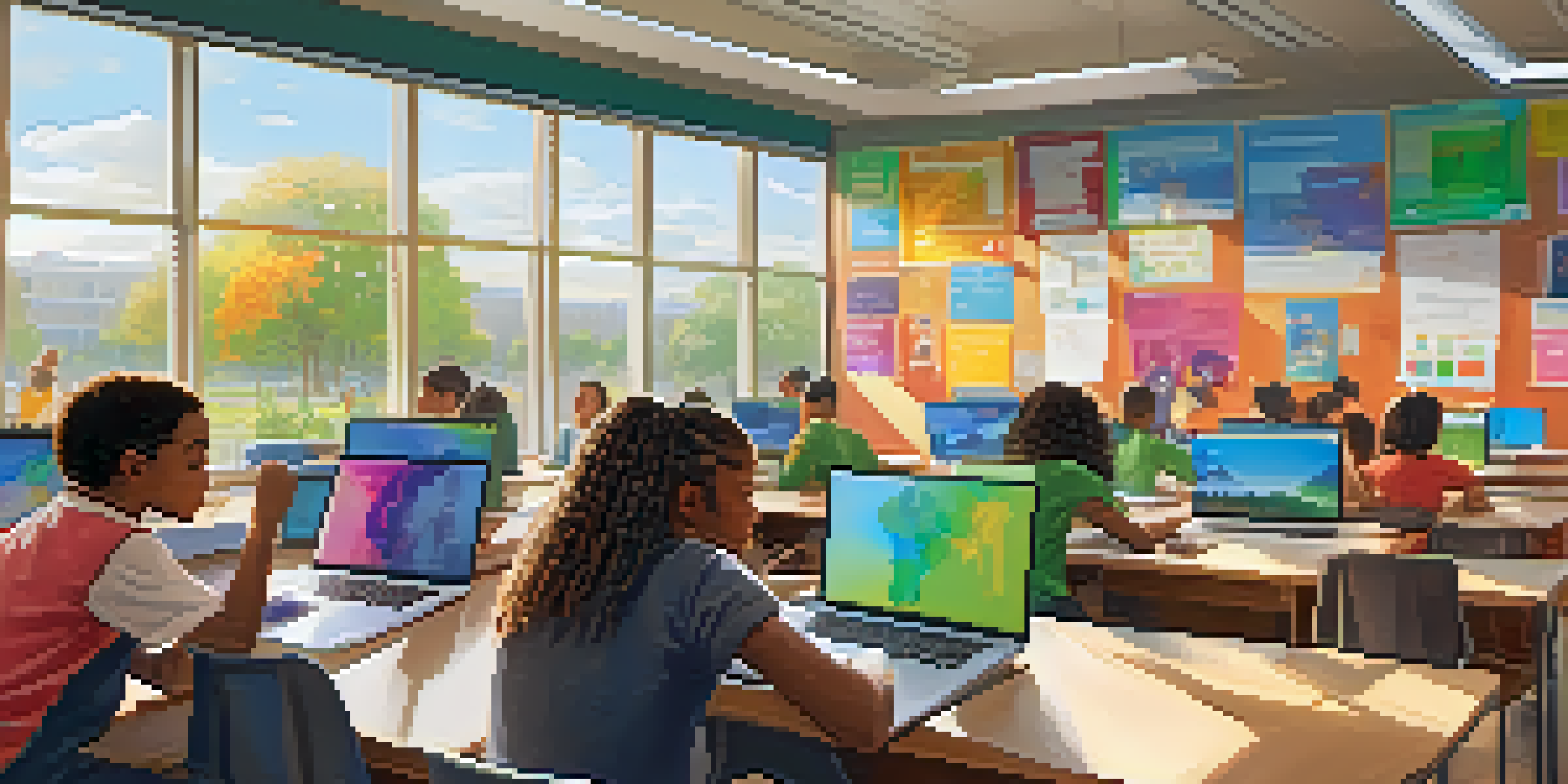The Effect of Global Pandemics on Educational Strategies

Understanding the Shift in Educational Paradigms
Global pandemics, like COVID-19, have dramatically shifted how education is delivered. Traditionally, classrooms were the primary setting for learning, but the necessity of social distancing led to a rapid transition to online platforms. This shift forced educators to rethink the way they engage with students, leading to innovative teaching strategies that may have otherwise taken years to develop.
Education is the most powerful weapon which you can use to change the world.
For instance, many teachers started using video conferencing tools to conduct live lessons, creating a more interactive environment. This approach not only maintained educational continuity but also made learning accessible to students in remote areas. The experience highlighted the importance of flexibility and adaptability in educational practices, which have now become essential skills for both teachers and students.
Moreover, the shift to online learning has encouraged the use of diverse resources, such as educational apps and online libraries. This variety not only keeps students engaged but also caters to different learning styles, ensuring that education remains inclusive. The pandemic has undeniably acted as a catalyst for change, shaping a more dynamic approach to education.
The Role of Technology in Modern Education
With the onset of global pandemics, technology has become a cornerstone of educational strategies. Schools and universities quickly adopted digital tools to facilitate learning, showing just how essential tech is in today’s educational landscape. From learning management systems to interactive online platforms, technology has enabled educators to create engaging and effective learning environments.

Take, for example, the rise of platforms like Zoom and Google Classroom, which have allowed real-time interaction between teachers and students. These tools not only support live lectures but also offer features like breakout rooms for group work, making collaborative projects possible despite physical separation. This shift has empowered students to take charge of their learning, fostering independence and critical thinking skills.
Shift to Online Learning
The transition to online education during the pandemic has led to innovative teaching strategies and greater accessibility for students.
Furthermore, technology has also opened the door for personalized learning experiences. With access to a wealth of online resources, students can pursue their interests at their own pace. This move towards individualized learning is likely to remain a staple in education, underscoring the lasting impact of global health crises on teaching methods.
Equity Challenges in Remote Learning Environments
While online education has its advantages, it also brings to light significant equity challenges. Not all students have equal access to the internet or the necessary devices for remote learning. This digital divide can exacerbate existing inequalities, leaving some students at a disadvantage while others thrive in the online environment.
The beautiful thing about learning is that no one can take it away from you.
In many cases, schools have had to find creative solutions to bridge this gap. Some institutions distributed laptops and Wi-Fi hotspots to students in need, while others partnered with local organizations to provide tech support. However, these efforts often highlighted the systemic issues within educational systems that need to be addressed long-term.
As we move forward, it’s crucial for educators and policymakers to prioritize equity in educational strategies. Ensuring that all students have access to the same resources will not only enhance learning outcomes but also foster a sense of community and belonging in the classroom, regardless of the setting.
Mental Health and Well-being in Education
Global pandemics have heightened awareness of mental health issues among students and educators alike. The abrupt shift to online learning, coupled with the isolation many experienced, has impacted the emotional well-being of both groups. Educational strategies now need to incorporate mental health support as a fundamental component of the learning experience.
Schools have begun to implement wellness programs and counseling services to address these concerns. For example, some institutions have introduced mindfulness practices and virtual support groups, providing students with a safe space to express their feelings. By prioritizing mental health, educational environments can foster resilience and a sense of belonging, which are essential for effective learning.
Equity and Access Challenges
The pandemic highlighted significant equity challenges, as not all students had equal access to technology and the internet for remote learning.
Additionally, the focus on well-being has encouraged educators to be more empathetic and flexible in their teaching approaches. Understanding the pressures students face, many are now offering more lenient deadlines and alternative assessment methods. This shift not only benefits students' mental health but also promotes a more supportive and understanding educational culture.
Redefining Curriculum and Assessment Methods
The need for adaptability during global pandemics has led to a re-evaluation of curricula and assessment methods. Traditional testing may not accurately reflect a student’s knowledge or skills in a remote learning environment. As a result, many educators are exploring alternative assessment strategies that provide a more holistic view of student learning.
For instance, project-based assessments and portfolios are gaining popularity as they allow students to showcase their understanding in creative ways. This shift encourages deeper engagement with the material and fosters critical thinking skills. By focusing on the application of knowledge rather than rote memorization, educators can better prepare students for real-world challenges.
Moreover, this rethinking of assessment is likely to persist beyond the pandemic. As educators embrace more flexible and diverse methods, they pave the way for a more inclusive educational system that values individual strengths and learning styles. This transformation has the potential to revolutionize how we measure success in education.
Collaboration and Community in Education
Global pandemics have underscored the importance of collaboration and community in education. Teachers, parents, and students have had to work together more than ever to ensure continuity of learning. This collective effort has fostered a stronger sense of community within educational environments, emphasizing the value of teamwork in overcoming challenges.
For example, many educators have engaged parents as partners in the learning process, providing them with resources and guidance to support their children at home. This collaboration has not only strengthened relationships but has also empowered parents to take an active role in their child's education. The shared experience of navigating remote learning has created bonds that can last beyond the pandemic.
Focus on Mental Health
There is an increased emphasis on incorporating mental health support into educational strategies to address the emotional well-being of students and educators.
Additionally, schools have formed networks to share best practices and resources, enhancing the collective knowledge of educators. By working together, they can address common challenges and innovate their teaching strategies. This spirit of collaboration is likely to shape the future of education, making it more community-oriented and responsive to the needs of students and families.
Future Implications for Educational Strategies
The impact of global pandemics on educational strategies is likely to have lasting implications. As we navigate through these unprecedented times, it’s clear that flexibility, technology, and a focus on mental health will play crucial roles in shaping the future of education. The lessons learned during this period can help create a more resilient educational system that can withstand future disruptions.
Moreover, the emphasis on equity and inclusive practices can lead to a more just educational landscape. By addressing the challenges highlighted during the pandemic, we can work towards ensuring that all students have access to quality education, regardless of their circumstances. This commitment to equity will be essential in fostering a brighter future for all learners.

Ultimately, the evolution of educational strategies will be a testament to the adaptability of teachers, students, and communities. As we embrace these changes, we can look forward to a more innovative and inclusive approach to education, one that is not only prepared for future challenges but also prioritizes the diverse needs of every learner.